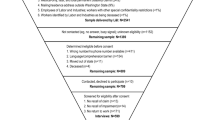Abstract
This paper presents testimony before the New York State Assembly Joint Hearings on Workers' Compensation. The testimony first establishes the background of the speaker in relation to the problems in the workers' compensation system. A brief summary of the problem including the increased prevalence of work-related musculoskeletal disorders and their contribution to work disability, the rising costs of insurance premiums, indemnity, and medical costs, and the percentage of payroll that workers' compensation costs consume in New York State is then presented. A review of problems injured workers and health care providers face is also considered. Following this, two proposals that represent a compromise position in relation to business and labor concerns are presented. The first relates to the implementation of state mandated prevention programs to reduce the risk of injury/illness and associated disability in areas accounting for the majority of the workers' compensation injuries/illnesses—low back and upper extremity disorders. It is proposed that individual employers receive incentives in the form of premium savings based upon actual program outcomes. The second proposal relates to the establishment of mutually agreed upon standards of health care for low back and upper extremity disorders similar to what currently exists in Minnesota. The potential benefits of these plans are discussed in relation to increasing costs and human suffering associated with work-related injuries/illness and disability. This paper is presented as an example of an approach to advocacy that health care providers can take to contribute to reform in the workers' compensation systems of their own states.
Similar content being viewed by others
References
Bureau of Labor Statistics.Occupational injuries and illnesses in the United States by industry, 1989: U.S. Department of Labor, Bulletin 2379. Washington, D.C.: U.S. Government Printing Office.
New York State Workers' Compensation Board.Compensated cases closed, 1988.
Business Council of New York State.BNA Workers' Compensation Report, 1993.
New York State Workers' Compensation Board. Office of Research and Statistics, 1993.
California Department of Insurance, Office of Policy Research.Lowering workers' compensation insurance costs by reducing injuries and illnesses at work, February 1993.
Chaffin DB, Fine LJ, eds.A national strategy for occupational musculoskeletal injuries—Implementation issues and research need. U.S. Department of Health and Human Services, Centers for Disease Control and Prevention, National Institute for Occupational Safety and Health, DHHS (NIOSH) Publication No. 93-101, November 1993.
Feuerstein M. A multidisciplinary approach to the prevention, evaluation, and management of work disability.J Occup Rehab 1991; 1: 5–12.
Habeck RV, Leahy MJ, Hunt HA, Chan F, Welch EM. Employer factors related to workers' compensation claims and disability management.Rehab Counsel Bull 1990; 34: 210–226.
U.S. Department of Labor, Occupational Safety and Health Administration.Ergonomics program management guidelines for meatpacking plants, OSHA, 1990.
Department of Labor, Occupational Safety and Health Administration.Ergonomic Safety and Health Management; Proposed Rule 29CFR Part 1910. Federal Register, August 3, 1992, pp. 34192–34200.
Armstrong TJ, Buckle, P, Fine LJ, Hagberg M, Jonsson B, Kilborn A, Kuorinka I, Silverstein BA, Sjogaard G, Viikari-Juntura E. A conceptual model of work-related neck and upper-limb musculoskeletal disorders.Scand J Work Environ Health 1993; 19: 73–84.
Spitzes WO, LeBlane FE, Dupuis M. Scientific approach to the assessment and management of activity-related spinal disorders.Spine 1987; 12: 7S.
State of Minnesota, Department of Labor and Industry.Emergency rules relating to workers' compensation: Treatment parameters, Minnesota Statues Section 176.83, subdivision 5, parts 5221.6010 to 5221.8900.
Author information
Authors and Affiliations
Rights and permissions
About this article
Cite this article
Feuerstein, M. Workers' compensation reform in New York State: A proposal to address medical, ergonomic, and psychological factors associated with work disability. J Occup Rehab 3, 125–134 (1993). https://doi.org/10.1007/BF01078282
Issue Date:
DOI: https://doi.org/10.1007/BF01078282




